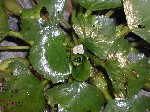
| Catalog of Species Search Results | ||
 |
:: Catalog of Species Search | |
 |
||
 |
||
 |
||
Trapa natans
( Water chestnut
European water chestnut ) |
COMMON NAME
Water chestnut
European water chestnut
FULL SCIENTIFIC NAME
Trapa natans L.
FAMILY NAME COMMON
Water-nut family
FAMILY SCIENTIFIC NAME
Trapaceae
IMAGES
 Floating rosettes |
 Close-up of flower |
 Incursion |
 Habit |
 Flower |
 Fruit |
 Close-up of Fruits |
NOMENCLATURE/SYNONYMS
Synonyms: None
DESCRIPTION
Trapa natans is an aquatic annual that grows as a rooted, floating plant. Its floating leaves are arranged in a rosette. Individually, the 2-4 cm (0.75-1.5 in.) long upper leaves are slightly rhombic to rhombic-ovate and are sharply dentate along the leaf margins. There are conspicuous veins on the lower surface as well as short, stiff hairs. The submerged lower leaves are alternate and feather-like and can reach up to 15 cm (6 in.) long. The petioles of the floating leaves are 0.6-1.8 m (2-6 ft.) long. The inconspicuous white flowers consist of four 8 mm (0.3 in.) long, white petals and four green sepals, and are located in the center of the rosette. Flowering begins in the northeastern United States in July and continues until the plants are killed by frost. The fruit is a four-horned nut-like structure about 3 cm (1.2 in.) wide that develops underwater. Fruits ripen in about a month and can remain viable for up to about twelve years. Each seed can give rise to ten to fifteen rosettes, and each rosette may produce as many as twenty seeds. Page References Bailey 734, Crow & Hellquist 209, Fernald 1050, Gleason & Cronquist 313, Holmgren 293, Magee & Ahles 768. See reference section below for full citations.
SIMILAR SPECIES
None
REPRODUCTIVE/DISPERSAL MECHANISMS
It has often been reported that waterfowl or water currents can move the seeds of Trapa natans long distances. However, the fruits weigh 6g and have been described as falling to the bottom of lakes "like sinkers," making them unlikely to be carried in the feathers of birds or downstream by moving water. The empty husks of the fruits do tend to float, possibly leading to the belief that they could be moved in these ways. Trapa natans may also disperse by fragmentation. Plant fragments can be carried by water, waterfowl and boats to new locations.
DISTRIBUTION
Trapa natans is native to the warm temperate regions of Eurasia. It has been naturalized in Australia and has recently (1998) been reported from Ontario, Canada. In the United States it is present in the northeast in the states of New York, New Jersey, Pennsylvania, Delaware, Maryland and Virginia. In New England, it has been reported from Massachusetts, Vermont, New Hampshire and Connecticut.
HISTORY OF INTRODUCTION IN NEW ENGLAND
Sometime before 1879, Trapa natans was intentionally planted by a gardener at the Cambridge botanical garden in Fresh Pond, Cambridge, MA. This gardener reported planting it in other ponds as well. It was also distributed up to Concord, MA, where it was planted in a pond near the Sudbury River. By 1899, it was extremely invasive in the pond and the river, and needed to be pulled out. There is an 1859 record from Concord, MA, but notes on the specimen and from the New England Botanical Club indicate that this date is in error, and that it was actually from 1879. By 1920, Trapa natans had reached western Massachusetts. Since then, it has spread into Lake Champlain in Vermont, the Nashua River in New Hampshire (1998) and most recently the Connecticut River in Connecticut in 1999. Any area that is downstream of these incursion sites is threatened.
HABITATS IN NEW ENGLAND
,Aquatic,Lake or Pond,River or Stream,Yard or GardenTrapa natans is commonly found in placid, nutrient rich lakes and rivers with a pH of 6.7-8.2. Plants have also been found in freshwater regions of estuaries and exposed mud flats.
THREATS
Threats from Trapa natans are a result of the surface mats it forms, which cause competition for nutrients and space. These plants also have little nutritional value for wildlife. Its blooms and decomposition may contribute to lower levels of dissolved oxygen in shallow water, and its spiny fruit can founder horses or dogs. Furthermore, the spread of water chestnut has economic impacts resulting from the plant's ability to impede fishing, hunting, swimming, boating and commercial navigation. Control measures to restore these uses can be expensive, such as the $5,249,685 spent from 1982 to 2005 to clean-up Lake Champlain.
MANAGEMENT LINKS
Cornell Cooperative Extension (Onondaga County)
General information including management options
DOCUMENTATION NEEDS
Documentation required: Photograph of floating rosette of leaves.
Best time for documentation: Summer, fall.
ADDITIONAL INFORMATION
Integrated Taxonomic Information System
Taxonomic information about the species
PLANTS database
General information and a map
New Hampshire Department of Environmental Services
General information
Invasive Plant Council of New York State
Photographs and general information
Vermont Department of Environmental Conservation
General information, drawings and management
The Nature Conservancy
Photographs
Invasivespecies.gov
Additional links
Invasive Plants of the Eastern United States (invasives.org)
Information on biological controls
Lake Champlain Basin Program
Information on Water Chestnut in Lake Champlain
National Park Service: plant invaders of Mid-Atlantic natural areas
General information
The Chesapeake Bay Program
General information
DATA RETRIEVAL
DataMAPS OF PLANT DISTRIBUTION IN NEW ENGLAND
Map